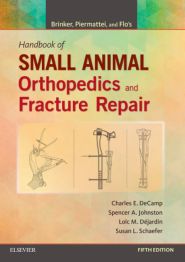New to this edition
- NEW! Advances in joint surgeries, specifically the knee, shoulder, and elbow, keep practitioners abreast of the latest technology and best practices.
- NEW! Coverage of minimally invasive surgery has been added to the many chapters.
- NEW! Advances in imaging (MRI, CT, and radiographs) are included to keep practitioners up to date on the latest technology.
- Updates on new fixation technologies include angle stable interlocking nails and locking plate fracture fixation systems.
- Updates on common surgeries include triple pelvic osteotomy and total hip replacement
- NEW! High-definition clinical photographs have been added to give readers a closer view of various fractures and repair techniques.
Author Information
By Charles E. DeCamp, DVM, MS, Professor and Chairperson Emeritus, Michigan State University, Staff Surgeon, Animal Surgical Center of Michigan, USA; Spencer A. Johnston, VMD, Diplomate, American College of Veterinary Surgeons; James and Marjorie Waggoner Professor; Head, Department of Small Animal Medicine and Surgery, College of Veterinary Medicine, University of Georgia, USA; Loïc M. Dejardin, DVM, MS, DACVS, DECVS, W.O. Brinker Endowed Chair of Veterinary Surgery, Professor – Small Animal Orthopaedic Surgery, ACVS Founding Fellow MIS Orthopaedics Small Animals, Michigan State University College of Veterinary Medicine; Susan Schaefer, MS, DVM, DACVS, ACVS Founding Fellow – Minimally Invasive Surgery and Professor Emerita, Department of Surgical Sciences, School of Veterinary Medicine, University of Wisconsin – Madison, USA
Part I: Diagnosis and Treatment of Fractures, Lameness and Joint Disease
1. Orthopedic Examination and Diagnostic Tools
2. Fractures: Classification, Diagnosis, and Treatment
3. Bone Grafting
4. Delayed Union and Nonunion
5. Treatment of Acute and Chronic Bone Infections
6. Arthrology
7. Principles of Joint Surgery
8. Arthroscopy in Joint Surgery
Part II: Fractures and Orthopedic Conditions of the Forelimb
9. Fractures of the Scapula
10. The Shoulder Joint
11. Fractures of the Humerus
12. The Elbow Joint
13. Fractures of the Radius and Ulna
14. Fractures and Other Orthopedic Conditions of the Carpus, Metacarpus, and Phalanges
Part III: Fractures and Orthopedic Conditions of the Hindlimb
15. Fractures of the Pelvis
16. The Hip Joint
17. Fractures of the Femur and Patella
18. The Stifle Joint
19. Fractures of the Tibia and Fibula
20. Fractures and Other Orthopedic Injuries of the Tarsus, Metatarsus, and Phalanges
Part IV: Other Fractures and Reconstruction of Bone Deformity
21. Fractures and Luxations of the Mandible and Maxilla
22. Fractures in Growing Animals
23. Correction of Abnormal Bone Growth and Healing
Part V: Miscellaneous Conditions of the Musculoskeletal System
24. Disease Conditions in Small Animals
Twenty-three years have passed since publication of the first edition of this book and the fourth edition takes advantage of considerable worldwide experience in this field. Many veterinary surgeons already know this comprehensive textbook and have had an opportunity to appreciate its usefulness in daily practice when managing all types of orthopaedic problems.
The format of the book is the usual one, as in the previous editions, with a first part dealing with the basic principles of the diagnosis and treatment of fractures, lameness and joint diseases, including fracture classification and all types of implants and systems of fixation. The second part describes the treatment of fractures and orthopaedic conditions of the fore- limb, while the third part considers the hind limb. The fourth part describes the approach to other fractures and to reconstruction of bone deformity, whilst the fifth part deals with miscellaneous conditions of the musculoskeletal system. This edition is considerably enriched by the excellent artwork of F. Dennis Giddings, the artist who first become famous with the milestone book for all orthopaedic surgeons, Piermattei's Atlas of Surgical Approaches to the bones and joints of the dog and cat.
The approach to each musculoskeletal condition is very comprehensive, following the original philosophy of Wade Brinker, taking care in the description of the pathology, the diagnostic work-up, surgical indications and planning, surgical approach, surgical techniques, complications and follow-up. For this reason this textbook is very useful to all veterinary surgeons when approaching veterinary orthopaedic and traumatology problems and willing to find the technical solution to any musculoskeletal case they may find in their daily practice.
For more experienced surgeons, already used to consult the previous editions, this fourth one will update their knowledge on the most recent diagnostic approaches, such as arthroscopy and the recently developed new techniques such as TPLO, guiding the reader in the choice of new solutions for several orthopaedic conditions. The addition of a new Author, Charles De Champ, is a guarantee for the continuous update of this textbook.
Aldo Vezzoni, (I) Med. Vet., SCMPA, Dipl. ECVS
FECAVA Vol. 16-2 October 2006




